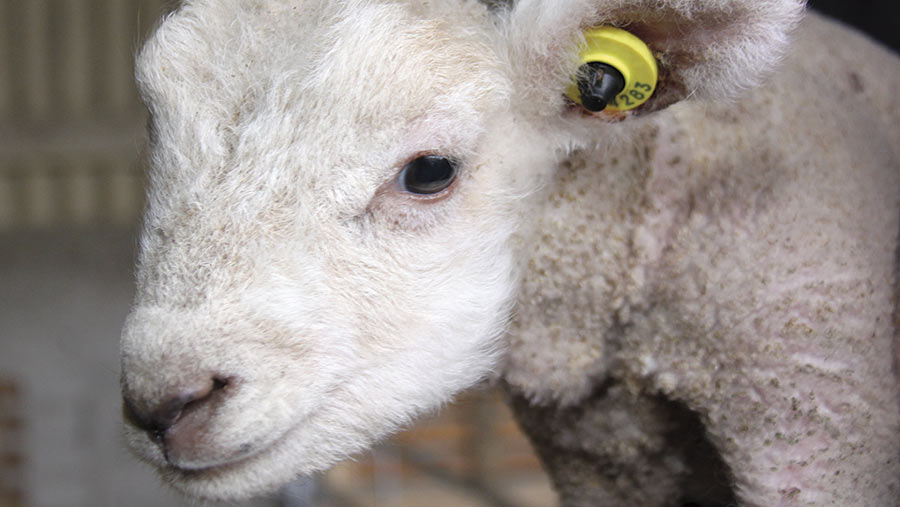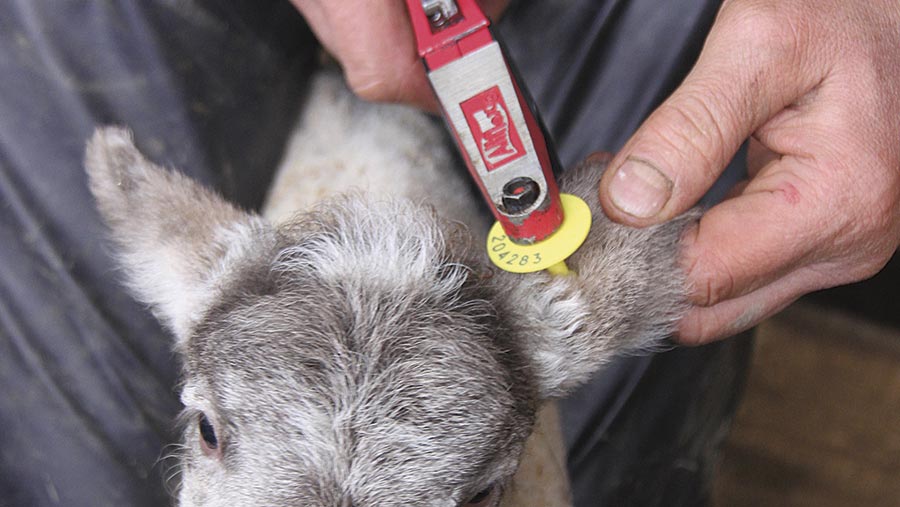How a sheep farm uses electronic tagging at birth to improve performance

Electronic tagging of lambs at birth has enabled one farmer to build a more accurate picture of flock performance and tweak management to maximise growth rates.
Rutland farmer Jamie Wild manages a flock of 2,200 breeding ewes on behalf of Dennis Tyler and Sons at Redhill Farm near Oakham.
The flocks at the 4,000-acre mixed arable and sheep farm are split into 2,000 commercial North Country Mules and 200 pedigree Charollais ewes.
See also: How recording and rotational grazing can lift lamb weight gains
As an early adopter of electronic ear tags, Mr Wild has been using EID tags on both the farm’s flocks for more than eight years, and for the past three years he has been tagging all lambs at birth.
“My primary aim has always been to make the entire sheep enterprise more efficient,” Mr Wild explains.
The use of EID tags from birth does away with illegible, handwritten documents and is a faster, more accurate and reliable way of keeping individual animal records as it removes human errors, especially during lambing when the pressure is on, he believes.
All 2,200 ewes lamb within a 21-day window in late February and early March and the aim is to get 70% of the commercial lambs away before the end of June.
“We started using electronic tags to build up a greater understanding of the pedigree flock’s performance to ensure we could meet these goals,” he says.

Each Charollais lamb is weighed at birth, eight weeks and 17 weeks of age, with eye muscle size and fat cover also assessed at 17 weeks.
“We started weighing our pedigrees earlier – 17 weeks is the best for us to find the 45kg we are looking for in the pedigrees. Ideally, whichever lamb weighs out and gets to 45kg the quickest is the one we are after.”
Gathering real-time data and matching it with individual animals has allowed Mr Wild to select stock with better growth rates.
Clear picture
The data Mr Wild gets from the tags gives him a clear picture of which lambs to cull and which to breed.

Jamie Wild
Over time, the farm has built up a database of each ewe’s EBV figures and her progeny’s performance statistics, which has allowed the selection of the best genetics to take the flock forwards.
“I would probably pick the top 30% of the ewe lambs to keep and breed from them; the rest would be killed. With ram lambs we would keep the top 50% and then either use them ourselves or sell them.
“What we can do is stand two tups, or a group up against each other, set a trial up, put them in a real situation within a group of sheep and the software just picks up how the lambs have done. This tells me which tups perform the best over a certain amount of years – it’s not rocket science, you just have to get the system in place,” explains Mr Wild.
Improvements in performance
Using the tags means Mr Wild can easily scrutinise each animal’s records to determine if the current management regime is working effectively and to identify where improvements can be made.
“We’ve seen big improvements in the Charollais ewes as a result and are also seeing a knock-on effect on the commercial flock.
“We are getting much more vigorous lambs; they’re a lot more hardy. I think a lot of that is down to the management of the tups. Rather than overfeeding them, they are allowed to grow more naturally, which is better for them.”
A lot of the grazing land on the farm is marginal, so lambs are creep fed to make sure they reach their target weights.
“It pays us to creep feed all our lambs; that fits in with the arable system,” Mr Wild says.
“But pedigree animals get a lot less concentrate; they only get it when they are pregnant or really need it.”
Mr Wild explains that some farmers are keen to switch to cross-bred tups because they perceive pedigrees to be lacking in hardiness. However, he insists this is not the case.
“It’s more likely that they have been managed badly through their first winter, kept inside and fed concentrate when they don’t need it. Then they fall to pieces when they live outside and eat grass,” says Mr Wild.
Mr Wild reckons the secret is to manage rams better through the winter, especially in their first year when they need to be outwintered and fed on grass.
Lamb tags at Redhill Farm
Each newborn lamb is fitted with an Allflex Mini EID Button tag. The circular shape of button tags means there is little, if any movement.
This means less ear wear, fewer ear infections and hardly any tag losses. “Retention rates are close to 100%, making the button tags as good as, if not better than, any other tag we’ve used,” Mr Wild says.
